Developing a Pilot Operational Oceanography System for an Enclosed Basin
Abstract
1. Introduction
Area of Study: The Gulf of Kalloni
- (1)
- (2)
- The ecological and socioeconomic significance of the gulf, which calls for the development of monitoring and forecasting infrastructure.
- (3)
- The vicinity of the gulf to the premises of the Department of Marine Sciences of the University of the Aegean, which would limit logistical costs and enable the exploitation of the Observatory for not only research, but also educational activities.
2. Materials and Methods
2.1. Observational component—Exchanges at the Strait
2.1.1. Submarine Telephone Cable Method
2.1.2. Volume Flux via Shipborne Acoustic Doppler Current Profiler Transects
2.1.3. Volume Flux via Moored Acoustic Doppler Current Profiler (ADCP) Method
2.1.4. Volume Flux via Rate of Change of Water Volume in the Basin
2.2. Observational Component—Hydrographic Measurements
2.3. Numerical Simulations
3. Results
3.1. Model Validation
3.2. Water Net Exchange through the Strait
3.3. Telephone Cable Data
4. Discussion
5. Conclusions
Author Contributions
Funding
Acknowledgments
Conflicts of Interest
References
- Healy, T.; Harada, K. Enclosed and Semi-Enclosed Coastal Seas. J. Coastal Res. 1991, 7, i–iv. Available online: www.jstor.org/stable/4297799 (accessed on 25 February 2020).
- Garvine, R.W.; Whitney, M.M. An estuarine box model of freshwater delivery to the coastal ocean for use in climate models. J. Mar. Res. 2006, 64, 173–194. [Google Scholar] [CrossRef]
- Hordoir, R.; Polcher, J.; Brun-Cottan, J.-C.; Madec, G. Towards a parametrization of river discharges into ocean general circulation models: A closure through energy conservation. Clim. Dyn. 2008, 31, 891–908. [Google Scholar] [CrossRef]
- Verri, G.; Pinardi, N.; Bryan, F.; Tseng, Y.; Coppini, G.; Clementi, E. A box model to represent estuarine dynamics in mesoscale resolution ocean models. Ocean Model. 2020, 148, 101587. [Google Scholar] [CrossRef]
- Raicevich, S.; Barausse, A.; Canadelli, E.; Fortibuoni, T.; Mazzoldi, C. Historical Ecology of Semi-Enclosed Basins and Coastal Areas: Past, Present and Future of Seas at Risk; Regional Studies in Marine Science; Elsevier: Amsterdam, the Netherlands, 2018; Volume 21, pp. 1–102. [Google Scholar] [CrossRef]
- Caddy, J. Marine catchment basin effects versus impacts of fisheries on semi-enclosed seas. ICES J. Mar. Sci. 2000, 57, 628–640. [Google Scholar] [CrossRef]
- Petihakis, G.; Triantafyllou, G.; Korres, G.; Tsiaras, K.; Theodorou, A. Ecosystem modelling: Towards the development of a management tool for a marine coastal system part-II, ecosystem processes and biogeochemical fluxes. J. Mar. Syst. 2012, 94, S49–S64. [Google Scholar] [CrossRef]
- Tintoré, J.; Pinardi, N.; Álvarez-Fanjul, E.; Aguiar, E.; Álvarez-Berastegui, D.; Bajo, M.; Balbin, R.; Bozzano, R.; Nardelli, B.B.; Cardin, V.; et al. Challenges for sustained observing and forecasting systems in the mediterranean sea. Front. Mar. Sci. 2019, 6, 568. [Google Scholar] [CrossRef]
- Martín Míguez, B.; Novellino, A.; Vinci, M.; Claus, S.; Calewaert, J.-B.; Vallius, H.; Schmitt, T.; Pititto, A.; Giorgetti, A.; Askew, N.; et al. The European marine observation and data network (EMODnet): Visions and roles of the gateway to marine data in Europe. Front. Mar. Sci. 2019, 6, 313. [Google Scholar] [CrossRef]
- Puillat, I.; Farcy, P.; Durand, D.; Karlson, B.; Petihakis, G.; Seppälä, J.; Sparnocchia, S. Progress in marine science supported by European joint coastal observation systems: The JERICO-RI research infrastructure. J. Mar. Syst. 2016, 162, 1–3. [Google Scholar] [CrossRef]
- Panayotidis, P.; Feretopoulou, J.; Montesanto, B. Benthic Vegetation as an Ecological Quality Descriptor in an Eastern Mediterranean Coastal Area (Kalloni Bay, Aegean Sea, Greece). Estuar. Coast. Shelf Sci. 1999, 48, 205–214. [Google Scholar] [CrossRef]
- Spatharis, S. Phytoplankton Diversity and Bloom Dynamics in Coastal Ecosystems under the Influence of Terrestrial Runoff. Ph.D. Thesis, University of the Aegean, Mytilene, Greece, 2007. [Google Scholar]
- Debenay, J.-P. Relationships between foraminiferal assemblages and hydrodynamics in the Gulf of Kalloni, Greece. J. Foraminifer. Res. 2005, 35, 327–343. [Google Scholar] [CrossRef]
- Leroi, A.M. The Lagoon: How Aristotle Invented Science; Penguin Books: London, UK, 2015; ISBN 9780143127987. [Google Scholar]
- Zenetos, A.; Papathanassiou, E. Community parameters and multivariate analysis as a means of assessing the effects of tannery effluents on macrobenthos. Mar. Pollut. Bull. 1989, 20, 176–181. [Google Scholar] [CrossRef]
- Diapoulis, A.; Bogdanos, K.; Haritonidis, S.; Konidis, A. The impact of pollution on the synthesis of the coastal benthos in the culf of Kalloni (Lesvos Island, Greece). Fresenius Environ. Bull. 1998, 7, 146–152. [Google Scholar]
- Kefalas, E.; Castritsi-Catharios, J.; Miliou, H. The impacts of scallop dredging on sponge assemblages in the Gulf of Kalloni (Aegean Sea, northeastern Mediterranean). ICES J. Mar. Sci. 2003, 60, 402–410. [Google Scholar] [CrossRef]
- Spatharis, S.; Danielidis, D.B.; Tsirtsis, G. Recurrent Pseudo-nitzschia calliantha (Bacillariophyceae) and Alexandrium insuetum (Dinophyceae) winter blooms induced by agricultural runoff. Harmful Algae 2007, 6, 811–822. [Google Scholar] [CrossRef]
- Zanou, B.; Kopke, A. Cost-effective reduction of eutrophication in the Gulf of Kalloni (Island of Lesvos, Greece). Med. Mar. Sc. 2001, 2, 15. [Google Scholar] [CrossRef][Green Version]
- Hughes, P. Submarine Cable Measurements of Tidal Currents in the Irish Sea. Limnol. Oceanogr. 1969, 14, 269–278. [Google Scholar] [CrossRef]
- Sanford, T.B. Motionally induced electric and magnetic fields in the sea. J. Geophys. Res. 1971, 76, 3476–3492. [Google Scholar] [CrossRef]
- Haidvogel, D.B.; Arango, H.G.; Hedstrom, K.; Beckmann, A.; Malanotte-Rizzoli, P.; Shchepetkin, A.F. Model evaluation experiments in the North Atlantic Basin: Simulations in nonlinear terrain-following coordinates. Dyn. Atmos. Oceans 2000, 32, 239–281. [Google Scholar] [CrossRef]
- Shchepetkin, A.F.; McWilliams, J.C. A method for computing horizontal pressure-gradient force in an oceanic model with a nonaligned vertical coordinate. J. Geophys. Res. 2003, 108, 3090. [Google Scholar] [CrossRef]
- Shchepetkin, A.F.; McWilliams, J.C. The Regional Ocean Modeling System: A split-explicit, free-surface, topography following coordinates ocean model. Ocean Model. 2005, 9, 347–404. [Google Scholar] [CrossRef]
- Haidvogel, D.B.; Beckmann, A. Numerical Ocean Circulation Modeling; Series on Environmental Science and Management; Imperial College Press: London, UK, 1999; Volume 2. [Google Scholar] [CrossRef]
- Shchepetkin, A.F.; McWilliams, J.C. Quasi-monotone advection schemes based on explicit locally adaptive dissipation. Mon. Weather Rev. 1998, 126, 1541–1580. [Google Scholar] [CrossRef]
- Smolarkiewicz, P.K.; Margolin, L.G. MPDATA: A Finite-Difference Solver for Geophysical Flows. J. Comput. Phys. 1998, 140, 459–480. [Google Scholar] [CrossRef]
- Mellor, G.L.; Yamada, T. Development of a turbulence closure model for geophysical fluid problems. Rev. Geophys. Space Phys. 1982, 20, 851–875. [Google Scholar] [CrossRef]
- Mamoutos, I.G.; Zervakis, V.; Tragou, E. The role of residual currents on the Aegean Sea. manuscript under preparation.
- Marchesiello, P.; McWilliams, J.C.; Shchepetkin, A.F. Open boundary conditions for long-term integration of regional ocean models. Ocean Model. 2001, 3, 1–20. [Google Scholar] [CrossRef]
- Chapman, D.C. Numerical treatment of cross-shelf open boundaries in a barotropic coastal ocean model. J. Phys. Oceanogr. 1985, 15, 1060–1075. [Google Scholar] [CrossRef]
- Flather, R.A. A tidal model of the northwest European continental shelf. Mem. de la Soc. R. de Sci. de Liege 1976, 6, 141–164. [Google Scholar]
- Chalazas, T.; Tzoraki, O.; Cooper, D.; Efstratiou, M.A.; Bakopoulos, V. Ecosystem service evaluation of streams for nutrients and bacteria purification in a grazed watershed. Fresenius Environ. Bull. 2017, 26, 7849–7859. [Google Scholar]
- Copernicus Climate Change Service (C3S) (2017): ERA5: Fifth generation of ECMWF atmospheric reanalyses of the global climate. Copernicus Climate Change Service Climate Data Store (CDS), 2019. Available online: https://cds.climate.copernicus.eu/cdsapp#!/home (accessed on 10 September 2019).
- Fairall, C.W.; Bradley, E.F.; Rogers, D.P.; Edson, J.B.; Young, G.S. Bulk parameterization of air-sea fluxes for tropical ocean-global atmosphere Coupled-Ocean Atmosphere Response Experiment. J. Geophys. Res. 1996, 101, 3747–3764. [Google Scholar] [CrossRef]
- Egbert, G.D.; Erofeeva, Y.S. Efficient inverse modeling of barotropic ocean tides. J. Atmos. Ocean. Technol. 2002, 19, 183–204. [Google Scholar] [CrossRef]
- Pisano, A.; Buongiorno Nardelli, B.; Tronconi, C.; Santoleri, R. The new Mediterranean optimally interpolated pathfinder AVHRR SST Dataset (1982–2012). Remote Sens. Environ. 2016, 176, 106–117. [Google Scholar] [CrossRef]
- Buongiorno Nardelli, B.; Tronconi, C.; Pisano, A.; Santoleri, R. High and Ultra-High resolution processing of satellite Sea Surface Temperature data over Southern European Seas in the framework of MyOcean project. Remote Sens. Environ. 2013, 129, 1–16. [Google Scholar] [CrossRef]
- Codiga, D. UTide Unified Tidal Analysis and Prediction Functions. 2020. Available online: https://www.mathworks.com/matlabcentral/fileexchange/46523-utide-unified-tidal-analysis-and-prediction-functions (accessed on 16 January 2020).
- Armenio, E.; De Serio, F.; Mossa, M. Analysis of data characterizing tide and current fluxes in coastal basins. Hydrol. Earth Syst. Sci. 2017, 21, 3441. [Google Scholar] [CrossRef]
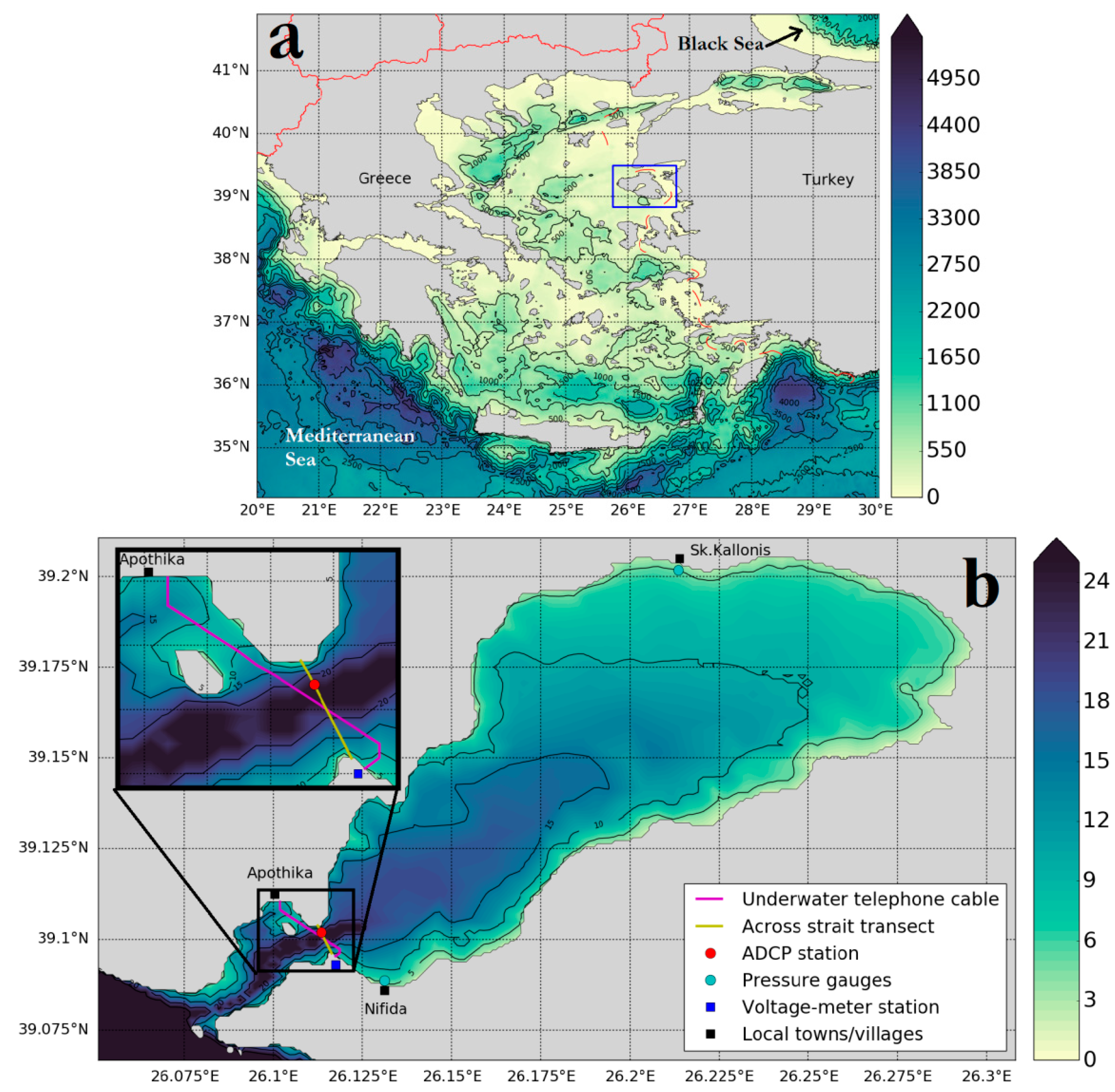
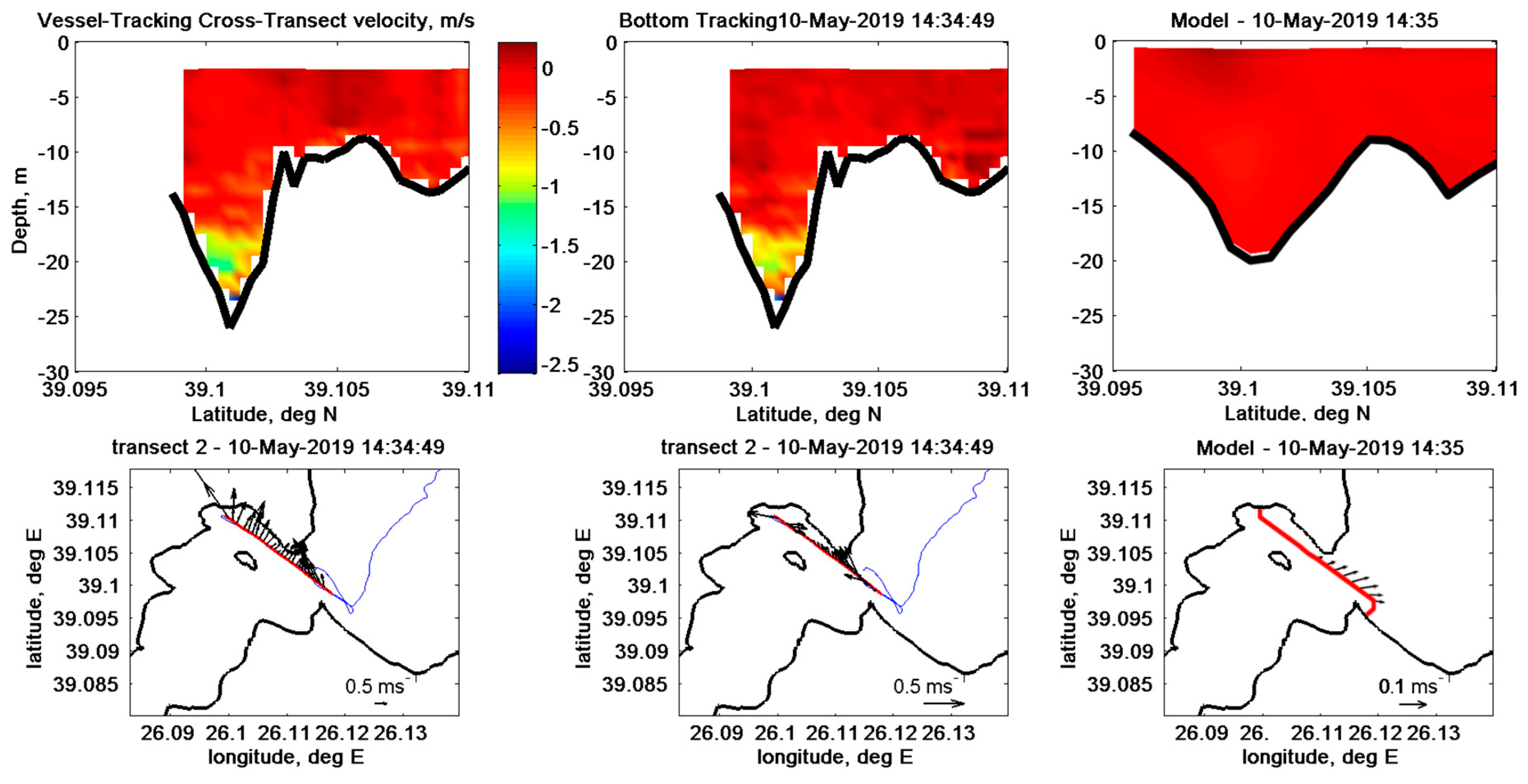

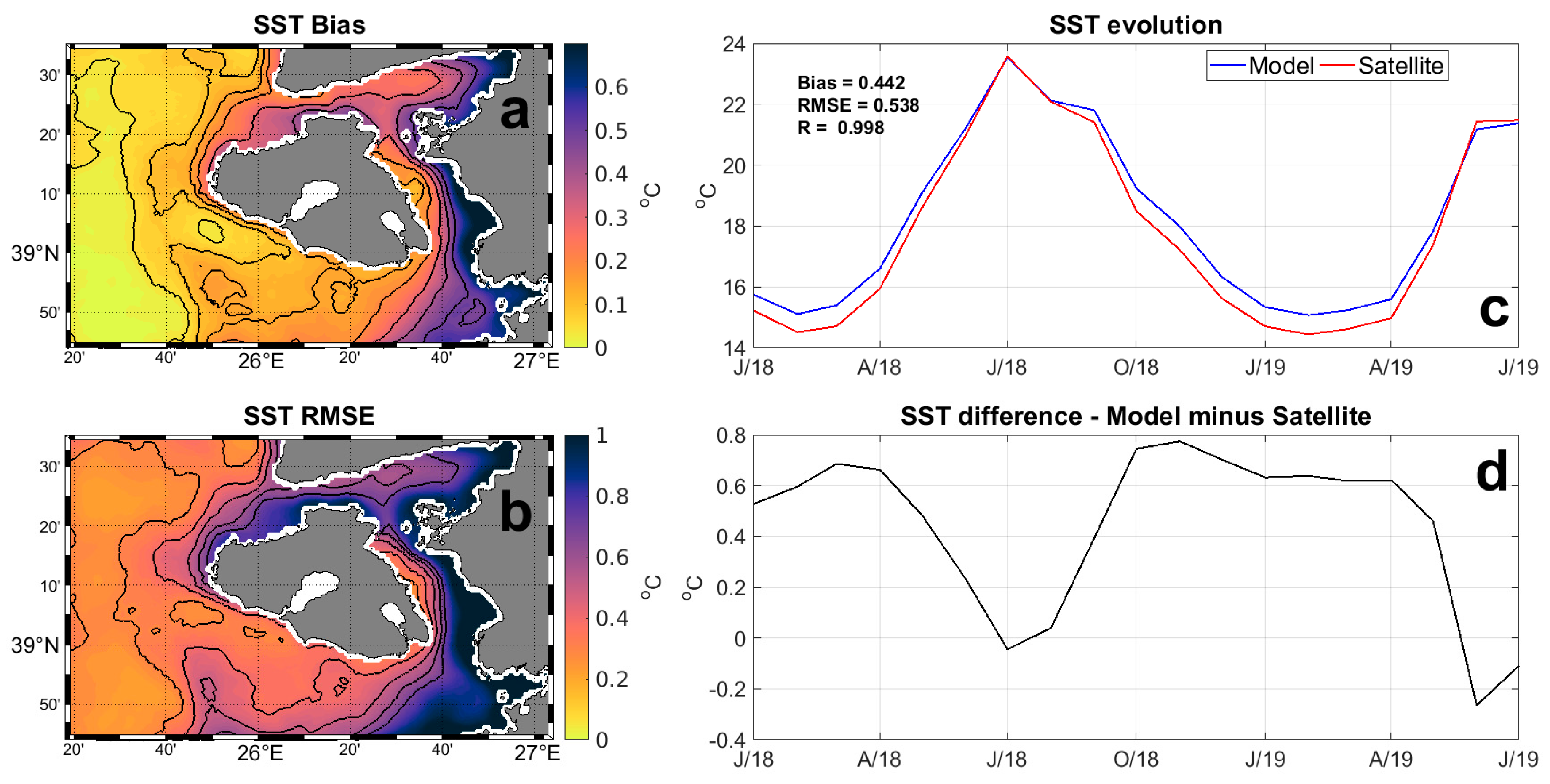
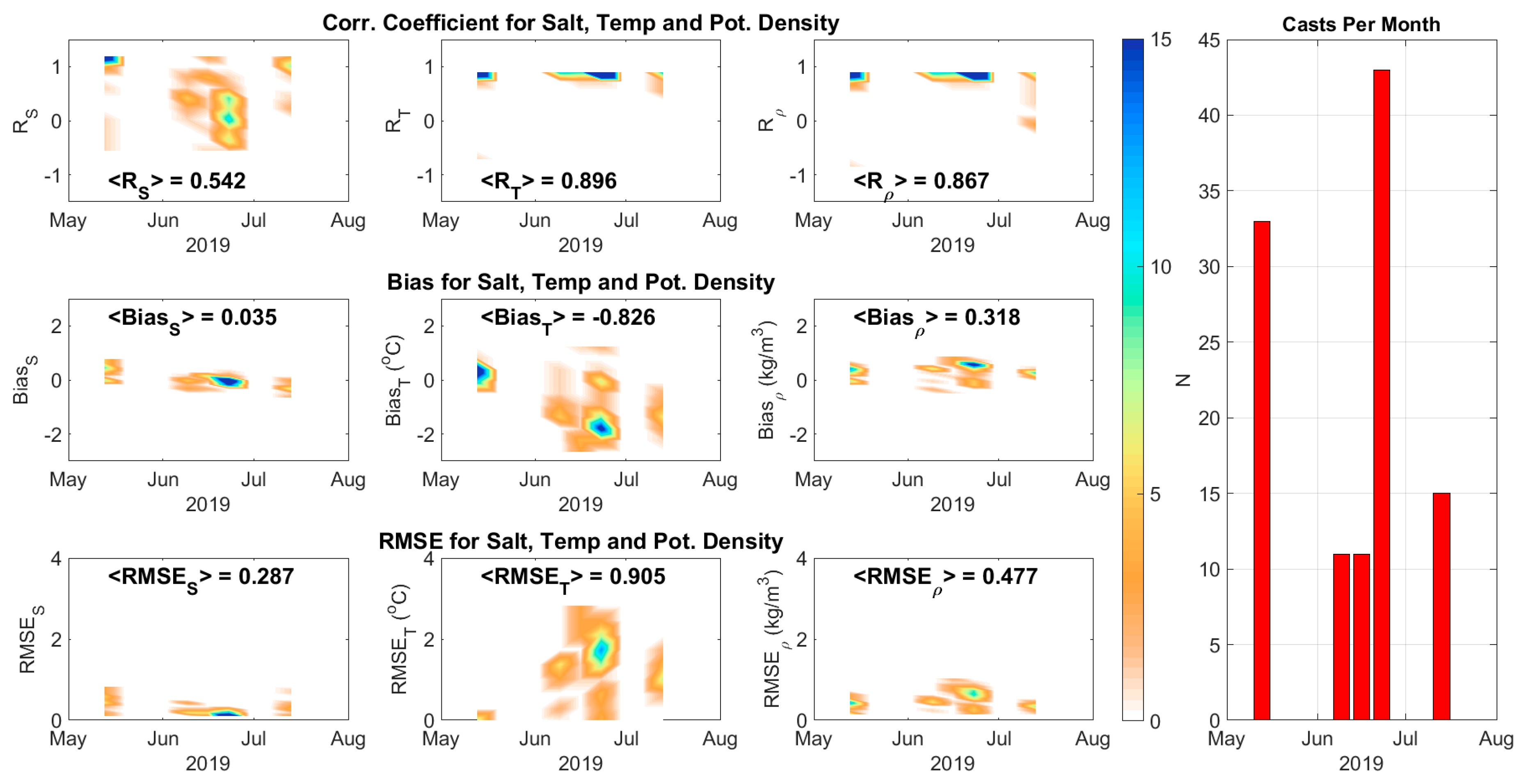
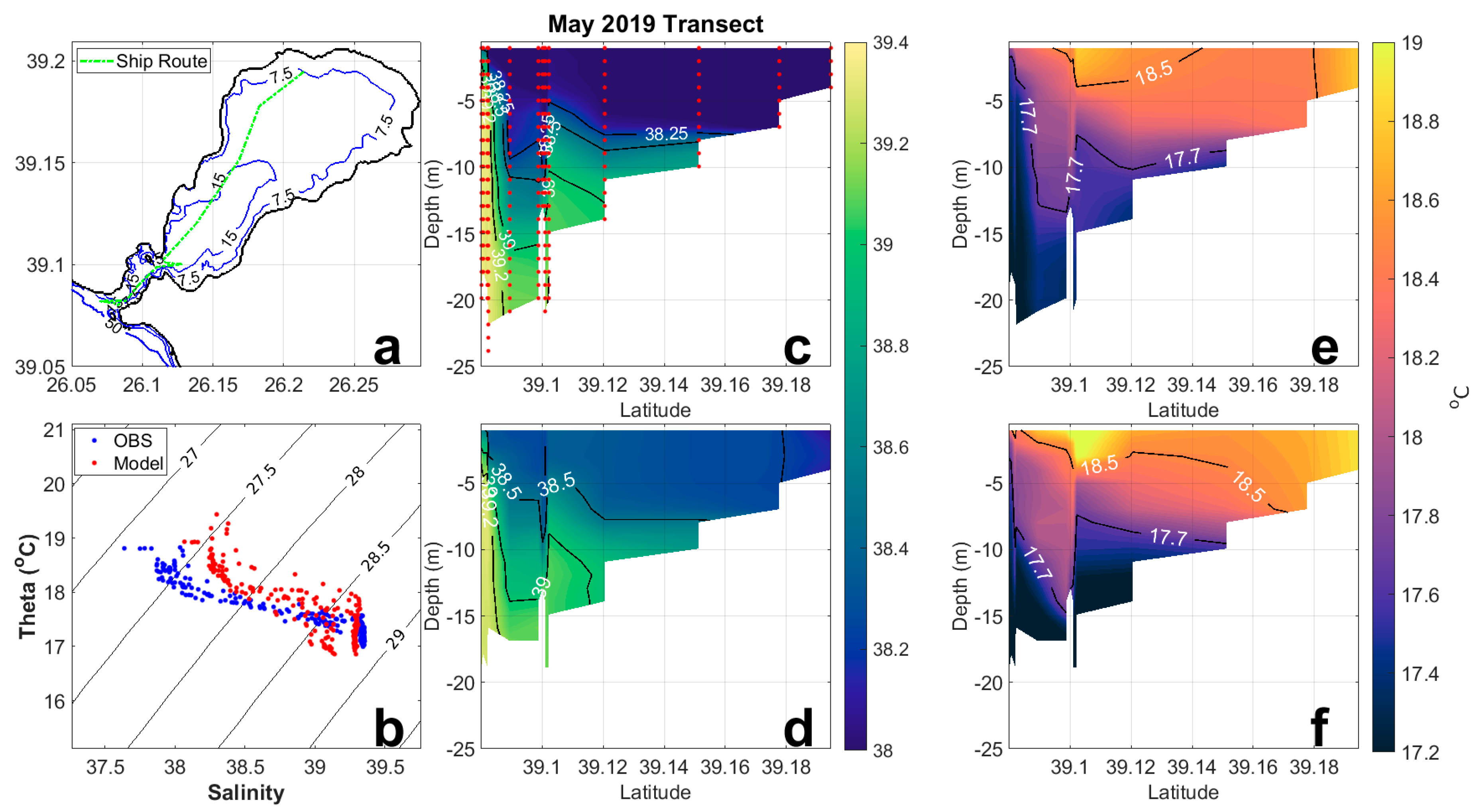
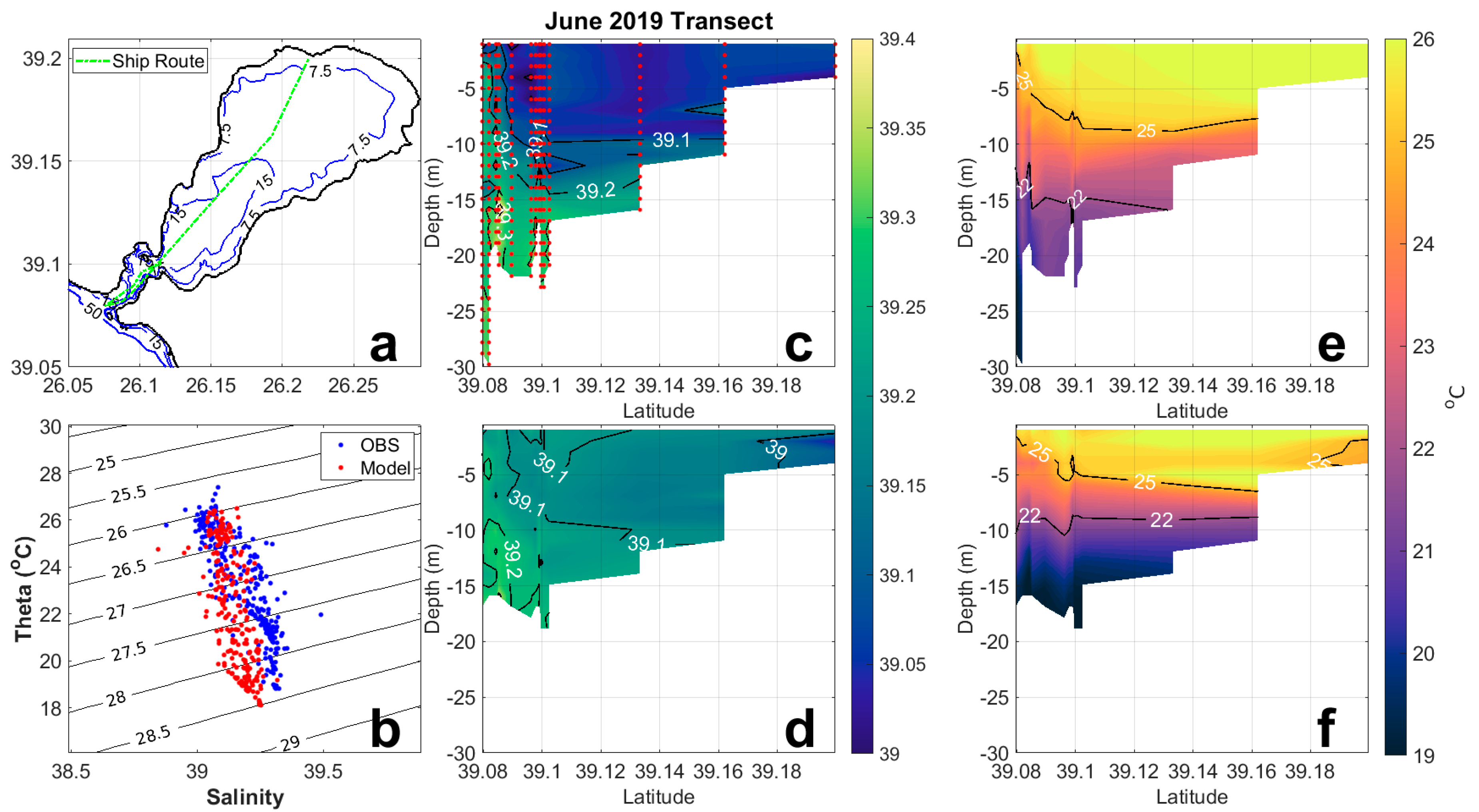
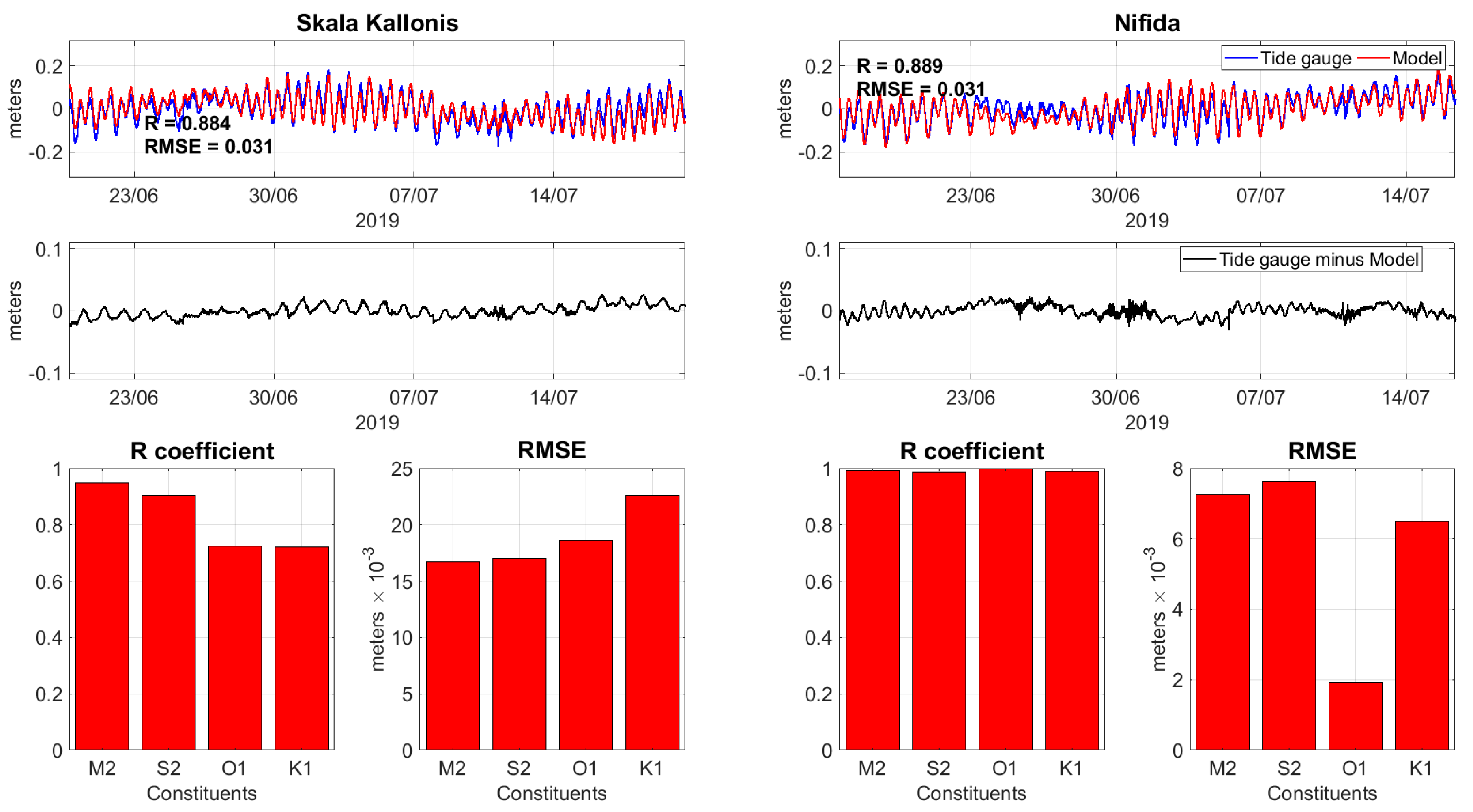
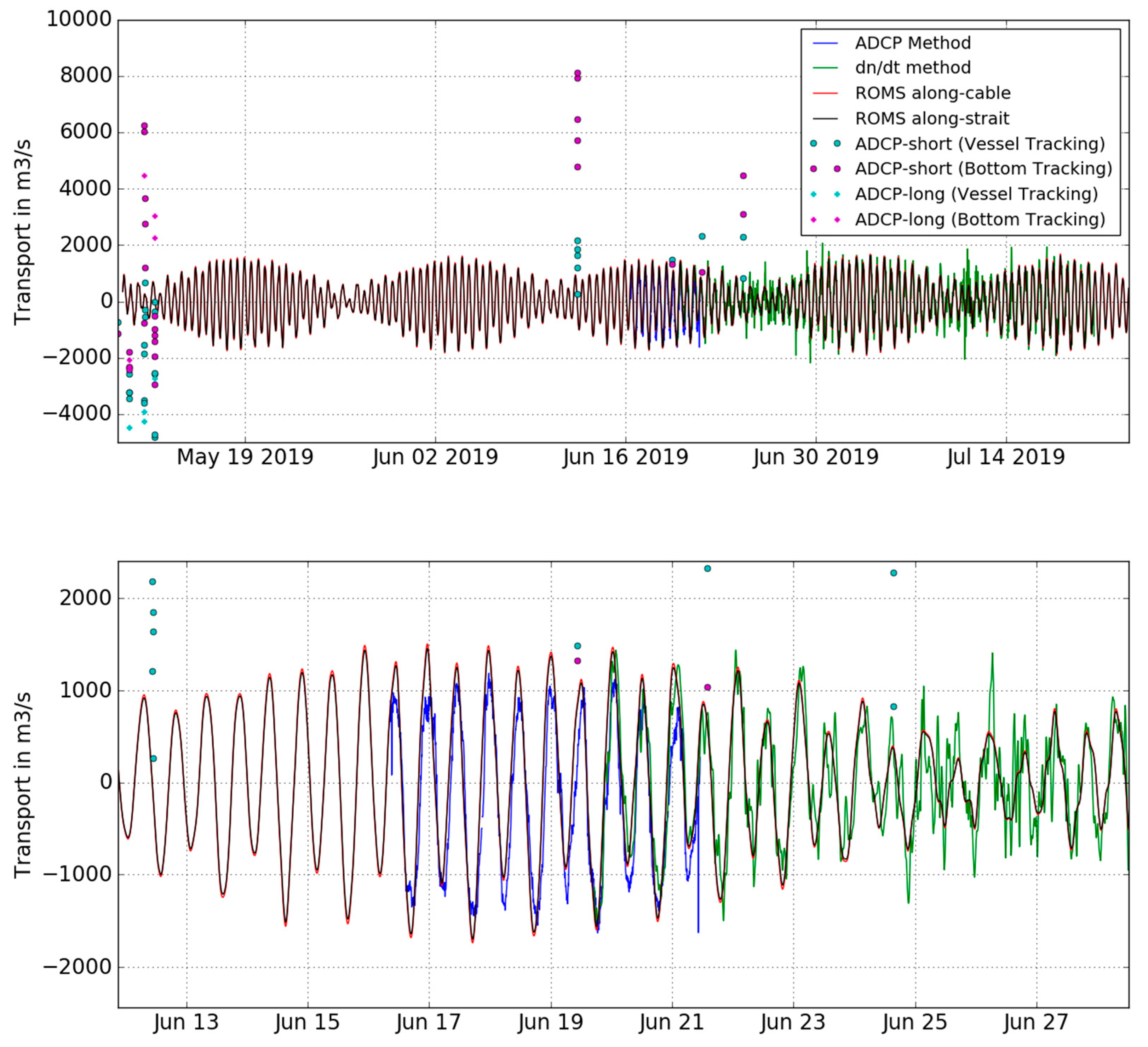
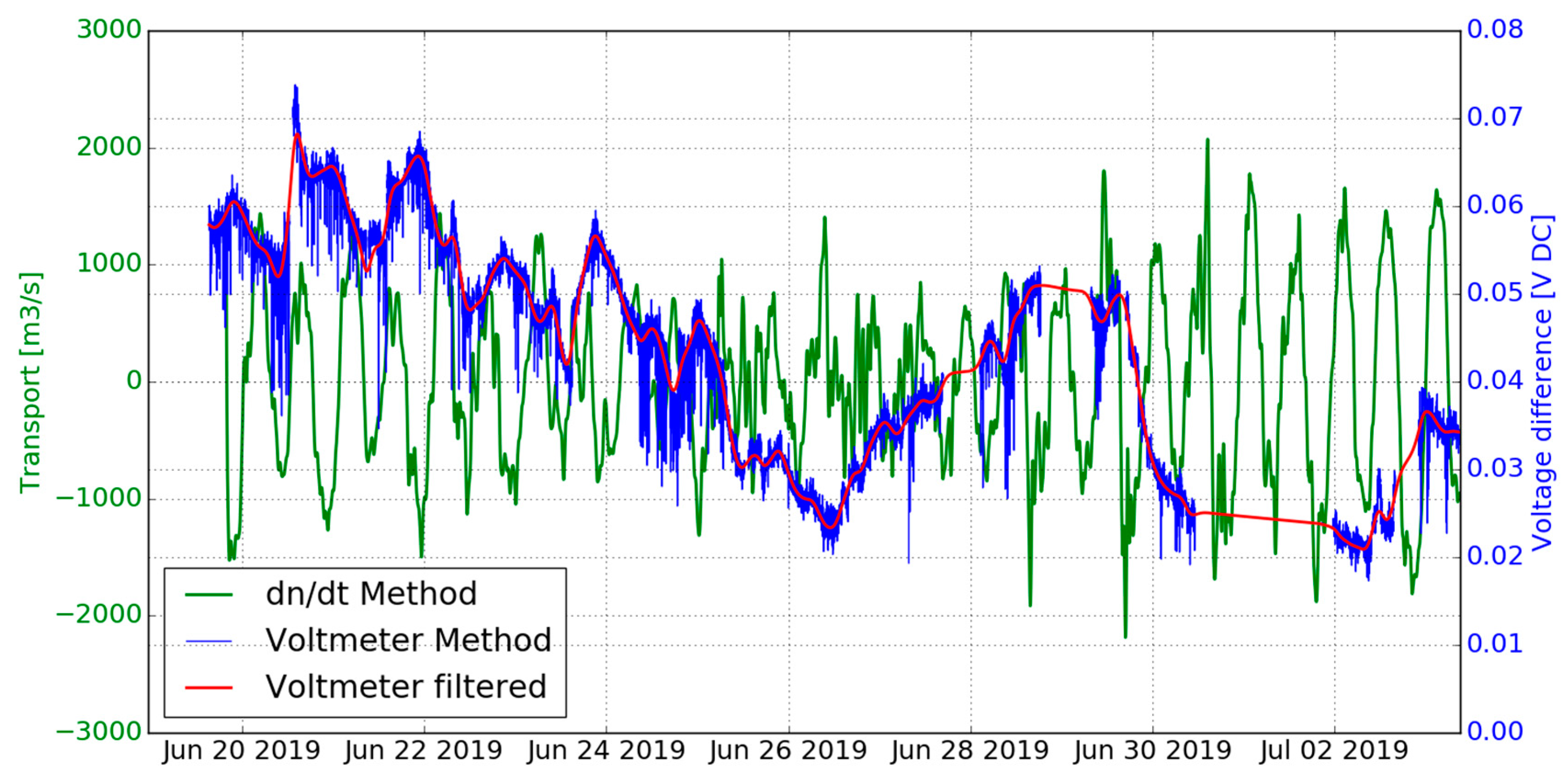
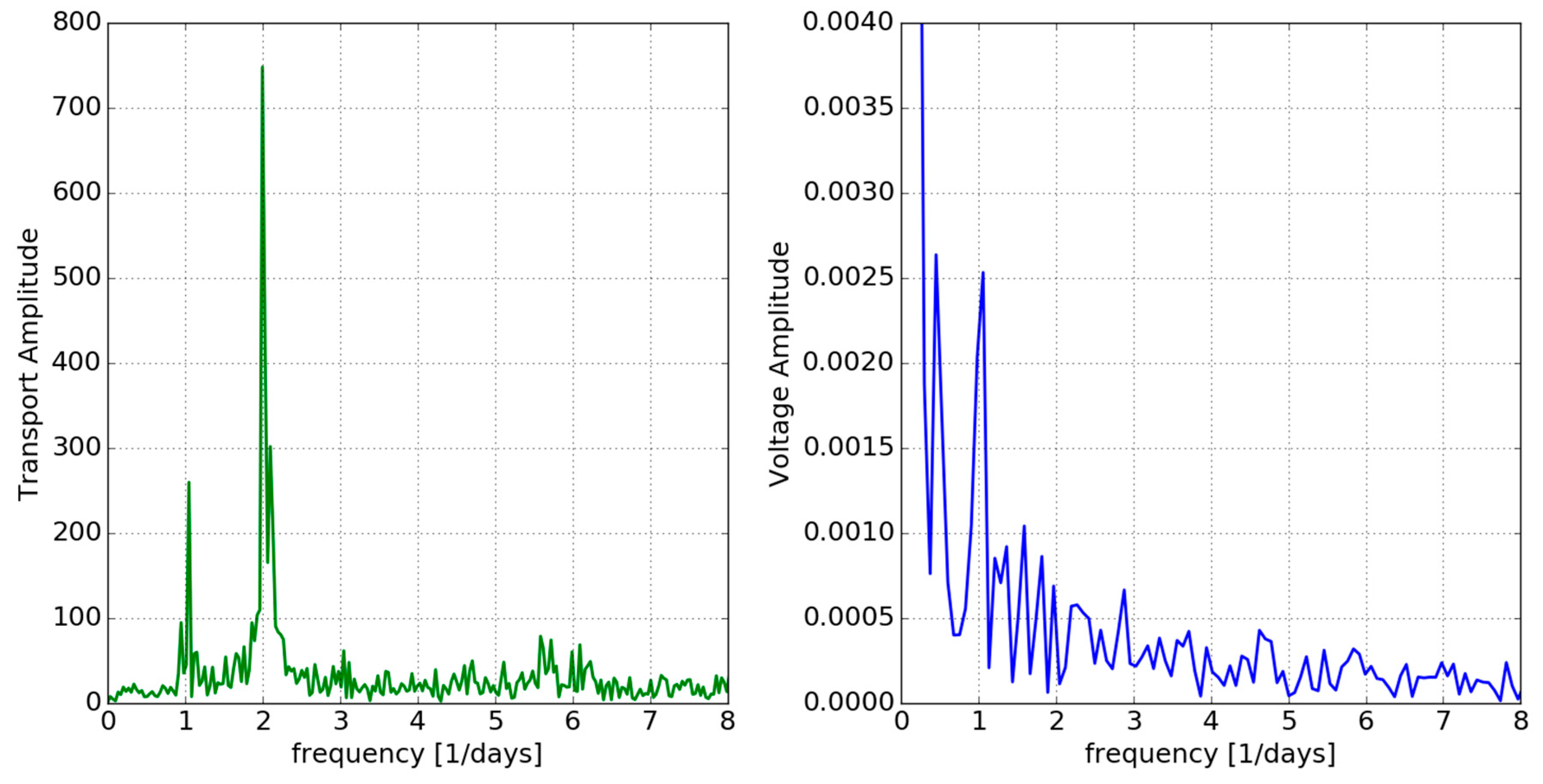
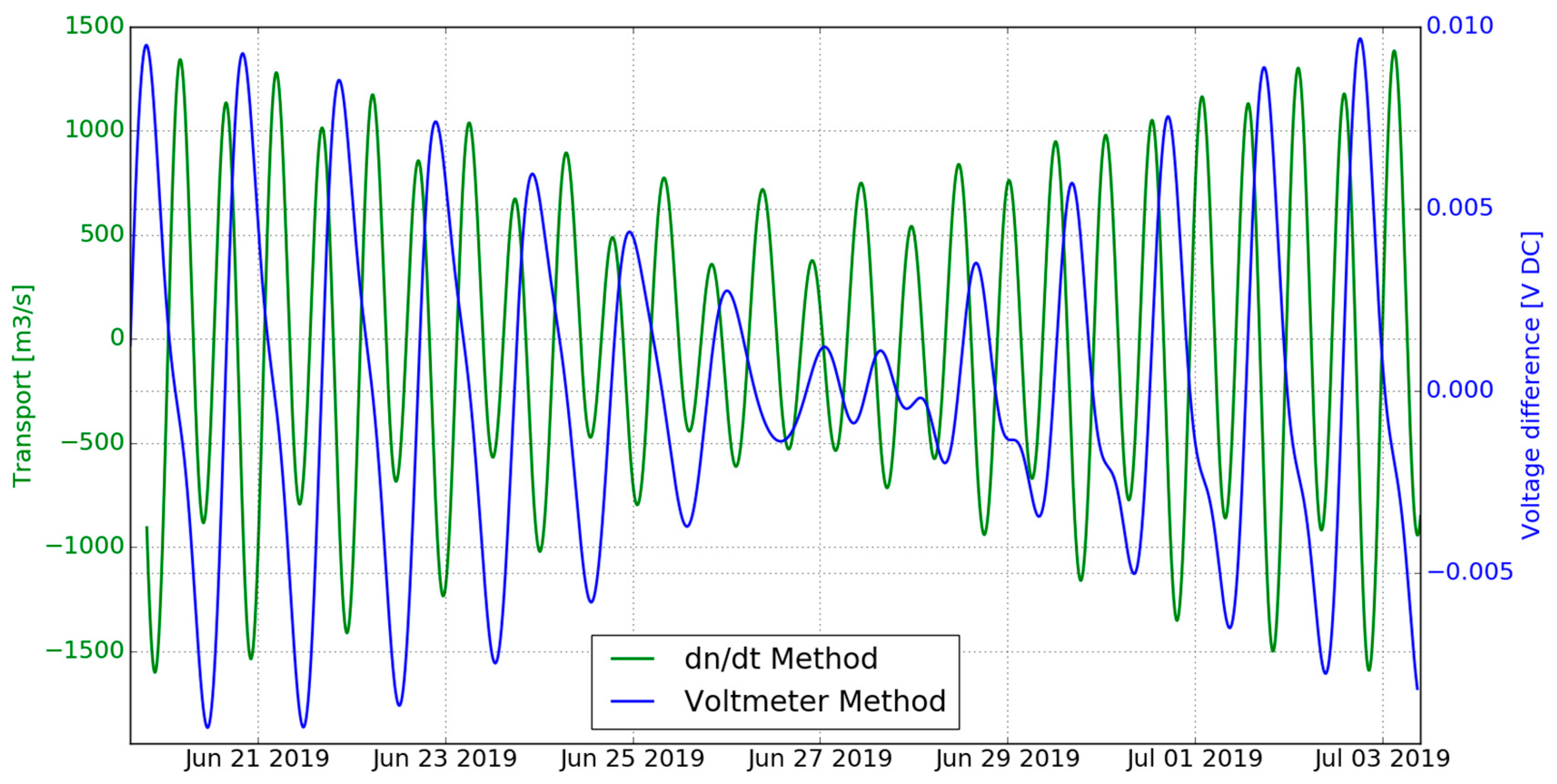
| Month | Date | Start Time (UTC) | End Time (UTC) | Sampling Interval (s) | Transect Type |
|---|---|---|---|---|---|
| May | 9/5/2019 | 18:10 | 18:13 | 30 | Long |
| 10/5/2019 | 11:27 | 11:33 | 30 | Short | |
| 10/5/2019 | 11:27 | 11:42 | 30 | Long | |
| 10/5/2019 | 11:42 | 11:57 | 30 | Long | |
| 10/5/2019 | 11:51 | 11:57 | 30 | Short | |
| 11/5/2019 | 13:49 | 13:55 | 10 | Short | |
| 11/5/2019 | 13:49 | 14:07 | 10 | Long | |
| 11/5/2019 | 14:08 | 14:26 | 10 | Long | |
| 11/5/2019 | 14:19 | 14:26 | 10 | Short | |
| 11/5/2019 | 14:29 | 14:40 | 10 | Long | |
| 11/5/2019 | 14:34 | 14:40 | 10 | Short | |
| 11/5/2019 | 14:40 | 14:46 | 10 | Short | |
| 12/5/2019 | 07:35 | 07:51 | 10 | Long | |
| 12/5/2019 | 07:35 | 07:41 | 10 | Short | |
| 12/5/2019 | 07:50 | 08:06 | 10 | Long | |
| 12/5/2019 | 08:00 | 08:06 | 10 | Short | |
| 12/5/2019 | 08:12 | 08:17 | 10 | Short | |
| 12/5/2019 | 08:17 | 08:22 | 10 | Short | |
| June | 12/6/2019 | 10:31 | 10:38 | 10 | Short |
| 12/6/2019 | 10:38 | 10:45 | 10 | Short | |
| 12/6/2019 | 10:45 | 10:52 | 10 | Short | |
| 12/6/2019 | 10:52 | 10:59 | 10 | Short | |
| 12/6/2019 | 11:00 | 11:96 | 10 | Short | |
| 19/6/2019 | 10:26 | 10:33 | 10 | Short | |
| 21/6/2019 | 13:51 | 13:56 | 10 | Short | |
| 24/6/2019 | 15:17 | 15:24 | 10 | Long | |
| 24/6/2019 | 15:24 | 15:30 | 10 | Long | |
| 24/6/2019 | 15:24 | 15:30 | 10 | Long |
| Harmonic | Method | Percentile Energy (%) | Amplitude (m) | Phase (degrees) |
|---|---|---|---|---|
| M2 | Tide Gauge: ROMS: | 57.76 57.30 | 0.0555 0.0609 | 61.2 55.0 |
| S2 | Tide Gauge: ROMS: | 8.41 14.59 | 0.0212 0.0307 | 91.3 81.0 |
| K1 | Tide Gauge: ROMS: | 22.47 22.30 | 0.0347 0.0380 | 333.8 332.0 |
| O1 | Tide Gauge: ROMS: | 4.14 3.06 | 0.0149 0.0141 | 304.0 300.0 |
| Harmonic | Method | Percentile Energy (%) | Amplitude (m) | Phase (degrees) |
|---|---|---|---|---|
| M2 | Tide Gauge: ROMS: | 54.79 61.34 | 0.0583 0.0604 | 64.0 58.1 |
| S2 | Tide Gauge: ROMS: | 8.39 11.21 | 0.0228 0.0266 | 93.2 82.3 |
| K1 | Tide Gauge: ROMS: | 20.17 16.71 | 0.0354 0.0301 | 335.8 334.3 |
| O1 | Tide Gauge: ROMS: | 3.67 1.53 | 0.0151 0.0101 | 304.8 301.0 |
© 2020 by the authors. Licensee MDPI, Basel, Switzerland. This article is an open access article distributed under the terms and conditions of the Creative Commons Attribution (CC BY) license (http://creativecommons.org/licenses/by/4.0/).
Share and Cite
Petalas, S.; Mamoutos, I.; Dimitrakopoulos, A.-A.; Sampatakaki, A.; Zervakis, V. Developing a Pilot Operational Oceanography System for an Enclosed Basin. J. Mar. Sci. Eng. 2020, 8, 336. https://doi.org/10.3390/jmse8050336
Petalas S, Mamoutos I, Dimitrakopoulos A-A, Sampatakaki A, Zervakis V. Developing a Pilot Operational Oceanography System for an Enclosed Basin. Journal of Marine Science and Engineering. 2020; 8(5):336. https://doi.org/10.3390/jmse8050336
Chicago/Turabian StylePetalas, Stamatios, Ioannis Mamoutos, Agisilaos-Alexandros Dimitrakopoulos, Angeliki Sampatakaki, and Vassilis Zervakis. 2020. "Developing a Pilot Operational Oceanography System for an Enclosed Basin" Journal of Marine Science and Engineering 8, no. 5: 336. https://doi.org/10.3390/jmse8050336
APA StylePetalas, S., Mamoutos, I., Dimitrakopoulos, A.-A., Sampatakaki, A., & Zervakis, V. (2020). Developing a Pilot Operational Oceanography System for an Enclosed Basin. Journal of Marine Science and Engineering, 8(5), 336. https://doi.org/10.3390/jmse8050336







